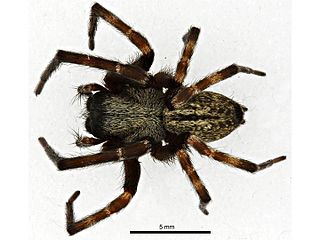
Wolf spiders are members of the family Lycosidae, from the Ancient Greek word "λύκος" meaning "wolf". They are robust and agile hunters with excellent eyesight. They live mostly in solitude and hunt alone, and do not spin webs. Some are opportunistic hunters pouncing upon prey as they find it or even chasing it over short distances. Some wait for passing prey in or near the mouth of a burrow.

Anyphaenidae is a family of araneomorph spiders, sometimes called anyphaenid sac spiders. They are distinguished from the sac spiders of the family Clubionidae and other spiders by having the abdominal spiracle placed one third to one half of the way anterior to the spinnerets toward the epigastric furrow on the underside of the abdomen. In most spiders the spiracle is just anterior to the spinnerets. Like clubionids, anyphaenids have eight eyes arranged in two rows, conical anterior spinnerets and are wandering predators that build silken retreats, or sacs, usually on plant terminals, between leaves, under bark or under rocks. There are more than 500 species in over 50 genera worldwide.

Oonopidae, also known as goblin spiders, is a family of spiders consisting of over 1,600 described species in about 113 genera worldwide, with total species diversity estimated at 2000 to 2500 species. The type genus of the family is OonopsKeyserling, 1835.

Ascyltus are a genus of jumping spiders in the family Salticidae that was first described by Ferdinand Anton Franz Karsch in 1878. As of December 2020, the genus contained 10 species. Ascyltus spiders utilize their vision in courtship, hunting, and navigation. They are typically large to medium sized salticids and often move relatively slowly. However, they are capable of agile jumps when moving, hunting, or to avoid predators. They have well developed book lungs and tracheal systems, and they are capable of utilizing both systems. Ascyltus have four pairs of eyes, with the anterior median pair being the most prominent. One distinguishable characteristic of the genus is their antero-lateral carapace, which is iridescently colored.

Castianeira is a genus of ant-like corinnid sac spiders first described by Eugen von Keyserling in 1879. They are found in Eurasia, Africa, and the Americas, but are absent from Australia. Twenty-six species are native to North America, and at least twice as many are native to Mexico and Central America.

Hogna is a genus of wolf spiders with more than 200 described species. It is found on all continents except Antarctica.

Prostheclina pallida is a species of spider in the family Salticidae, native to Eastern Australia. It was described by Keyserling in 1882, and remained the only species in the genus until 2007, when six more species were described.

The white-fronted woodpecker is a species of bird in the family Picidae. It is found mainly in Bolivia, Paraguay and Argentina. Its natural habitats are subtropical or tropical dry forests, subtropical or tropical dry shrubland, and subtropical or tropical high-altitude shrubland.
Sanogasta is a genus of South American anyphaenid sac spiders first described by Cândido Firmino de Mello-Leitão in 1941.

Scotophaeus blackwalli, also known as the mouse spider, is a species of spider belonging to the family Gnaphosidae.
Laminacauda is a genus of dwarf spiders that was first described by Alfred Frank Millidge in 1985.
Catumiri is a genus of South American tarantulas that was first described by J. P. L. Guadanucci in 2004. The name is derived from the Tupi "Catumiri", meaning "very small".

Metaltella is a genus of South American intertidal spiders first described by Cândido Firmino de Mello-Leitão in 1931. One species, Metaltella simoni, has been introduced to North America.

Textrix dendiculata, the toothed weaver, is a funnel web spider of the family Agelenidae found in much of Europe. It was described by the French entomologist Guillaume-Antoine Olivier in 1789. An older name coined by Martini & Goeze in 1778, Aranea cruciger, has been declared a nomen oblitum, allowing Olivier's later name to stand.

Badumna longinqua or the grey house spider is a species of spiders in the family Desidae. Native to eastern Australia, it has been introduced into New Zealand, Japan, the United States, Mexico, and Uruguay.

Arachosia is a genus of anyphaenid sac spiders that was first described by Octavius Pickard-Cambridge in 1882.

Cosmophasis baehrae is a species of jumping spider found in Australia. It is named after entomologist Barbara Baehr.
Josa is a genus of South American anyphaenid sac spiders first described by Eugen von Keyserling in 1891. It is a senior synonym of "Gayenella", "Haptisus", "Olbophthalmus", and "Pelayo".

Zenodorus orbiculatus, the round ant eater, is a species of ant-hunting jumping spider found in Australia. The species was first formally named by Eugen von Keyserling in 1881 as Hasarius orbiculatus.
Mastophora extraordinaria is a species of spider in the orb-weaver spider family Araneidae. It is found in South America. Like some other species of the genus Mastophora, adult females resemble bird droppings. Mastophora species, including M. extraordinaria, are "bolas spiders" – adult females capture their prey by using a sticky drop on the end of a single line which they swing at the target, usually a male moth attracted by the release of an analogue of the attractant sex pheromone produced by the female moth. Juveniles and adult males do not use a bolas, catching prey with their legs alone.
















